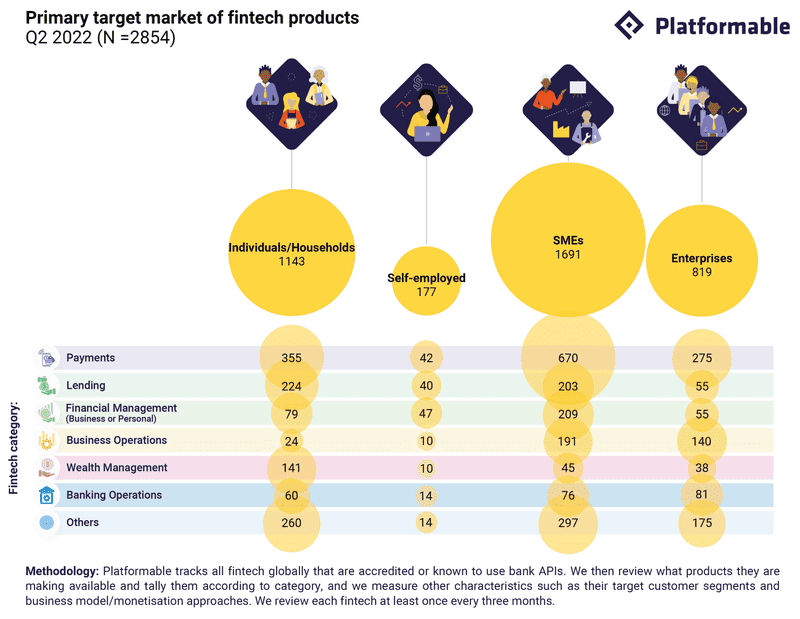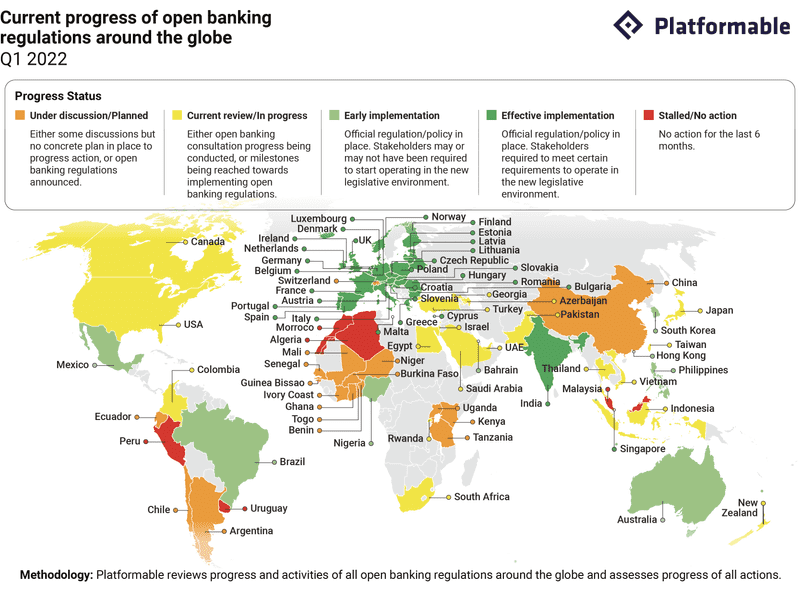Open Banking Trends Q2 2020: Benefits for API Industry
8 min read

Last updated: 6 August, 2020
Banks are either being mandated (through regulations) or choosing to open APIs. Now, with COVID-19 impacts, banks are speeding up their digital transformation efforts. This will require investment in internal API teams to connect systems, work with partners, and speed up product development.
So there are a lot of API-related activities on the horizon, and many banks will need help. They will need a full range of API tools and industry expertise to support them. From our analysis using our 5 wins open banking data model, in our Q1 2020 Open Banking Trends report, we identified 118 API providers (24% out of 502 overall) that already have bank and fintech clients

Data on benefits of open banking for the API industry were quantified in our Q1 Trends report
That leaves a lot of opportunity for other API providers to build up their bank and fintech customer base. But how? Like governments, banks have traditionally required longer sales times and while that will speed up now, it can still be difficult to identify which banks to target and how to talk with them.
James Hirst, Co-founder of open source API management platform Tyk, has onboarded around 20 banks and fintech providers, and some government entities like tax authorities, into their customer base.

Tyk is focused on enabling interconnectivity between systems and between devices, and that starts with building an API Management platform, which is now used globally and has seen steady growth amongst the banking and fintech industries. “Whether handling tax affairs or healthcare for national governments or powering consumer and back-end services for some of the world’s best-known banks and investment firms, the Tyk open-source gateway has enabled the most security-conscious of organisations to design, secure, control and manage their APIs,” James wrote earlier this year.
3 key recommendations from Tyk’s sales playbook
James recommends that API providers focus on three key questions to evaluate the sales opportunity:
- How does your prospect develop products now?
- What is your prospect’s current architecture?
- Who is leading their efforts?
Before digging into those three criteria, however, a quick assessment of the size of the bank helps. James says Tyk tends to shy away from Tier 1 banks: “It’s not in our interest to sell to that scale. We are happy to engage with large banks, but we are careful to open conversations early about the client's expectations. It's important that the proposed solution meets the client's needs in terms of scale and service, not just feature set. On that basis, contracting with Tier 1 banks requires a very different proposition if it is to be a win-win for both parties."
How does your prospect develop products now?
Before getting into technical considerations, James suggests starting with an understanding of the culture and business dynamics of the bank. “Understand how they are developing products and services internally, put aside their tech stack to start. Are they big change programs, using waterfall delivery and with tightly interlinked project plans for 2-3 years? Is there a team internally that will be able to implement our product? Different companies have different approaches. For example, we have seen a challenger bank who brought in a CTO whose whole experience was in running a polyglot, microservices architecture. We’ve also seen high street retail banks: where there is a desire for change but it is so slow, requires a great deal of building consensus, and they were much more risk averse”, says James.
This can help in understanding if your product can be of use to the bank prospect at this time, or whether the sales timeline might end up being drawn out.
What is your prospect’s current architecture?
After understanding the organisational processes, then Tyk is able to assess the bank’s architecture. As a modular platform, James says Tyk is looking for a bank’s microservices architecture, interest in containerization, and multi-cloud approaches. Tyk works with a number of clients, for example, where the external/open banking API catalogue uses a SaaS offering while internally, the company uses Tyk “self-managed” installed in their own infrastructure.
Many banks have multiple projects, often even managed by individual teams, so it may be worth trying to sell to one product team first and focus on demonstrating the power of your tooling. “Banks can be polyglot, and they have legacy,” says James. “If they are looking at changing what they are doing, you don’t need to sell them a central platform. Often there will be slow movement, so you can start by selling to one product or team first.”
Who is leading their efforts?
Finally, during the sales preparation process, James looks at who is leading internal efforts at the bank. “As a tech provider, do they have the in-house capability to run it internally, or do they have relationships with a consultancy who will do the change?” James asks.
One concern for James is that working with innovation teams can be a dead-end. At Platformable, we have also often seen that the way innovation teams are structured within larger corporations is more as a staff morale and training exercise. The projects proposed by innovation teams rarely pass the prototype stage, and the staff involved in the short-term project then go back to their usual work. They may be more motivated and have developed some design-thinking skills they can use in their ongoing work, but the innovation team project they were working on is left without an internal sponsor and with no way to integrate into the wider organisational operations. “There is a danger of getting dragged into innovation teams,” warns James.
The sales process
Another sales process advantage for Tyk: open source. “There is real strength in our open source model,” says James. “Banks tell us ‘we are selecting you because we want to go through the open source tech line by line and deploy that securely internally’.”
If your API tooling isn’t open source, you may need to consider other ways to allow that level of insight into your code by bank prospects. (For example, there are some code-in-escrow products that API providers have considered as a way of sharing their code with high-level prospects in the past. Others have used non-disclosure agreements.)
James agrees: “Aim for transparency and openness, let someone go and look at the code. But from a procurement perspective, you also need some contractual cover.”
Another strength for Tyk is that their product offering is modular, so banks can select the product elements they want to use. James strongly recommends that other API tool providers make sure they can also offer a component-based offering.
James gives two key examples:
- “Integrate into what people have got, don’t impose your own, especially around things like role-based access controls. Map to the existing security infrastructure they have. Banks often won’t let the SaaS or API tools create logins for users. So make sure you can integrate with the best-in-breed. We work with identity providers like Ping and Okta rather than build out our own solution.”
- “For DevOps oversight, banks don’t need to use the dashboard we offer in Tyk. We have Tyk Git and other tools so that banks can manage how they want to monitor their own CI/CD pipeline.”
For Tyk, the sales onboarding process of banks hasn’t generally required them to change their product feature set. However, we have heard from other API providers who said that to meet certain requirements of bank prospects (most commonly, the ability for SaaS-delivered products to work behind a firewall), they needed to add some additional features. The benefit for these providers has been that by doing so, they were then enterprise-ready to sell beyond just that bank prospect.
Having bank customers can be a solid income source and opportunity for API tool providers to grow. But onboarding bank customers through a sales process requires strategy, and that starts with analysing whether the bank is a good fit for your API product, not the other way around. After that is understood, you can then look at how your services fit with the bank’s needs.
Measuring the value of open banking to the API industry
Platformable's 5 Wins model identifies key stakeholders who should benefit from open banking. We include the API industry as a key stakeholder. Banks are large enterprises, so as they start using API services, they advance the industry through becoming paying customers, but more importantly, they help mature the API sector and software development expertise overall. We use apidays and Mehdi Medjaoui's API Landscape as our primary source for identifying API service providers when analysing interactions with banking.

Special thanks to James Higginbotham for helping connect Platformable with James and the Tyk team.
Acknowledgements
We would like to thank our network of knowledge experts who were able to provide feedback and advice on the trends and data as we prepared the Q2 Open Banking Trends report series including: S. Adeel Ali, Loubna Bazine, Adrita Bhor, Yves Bovin, Tom Carpenter, Don Cardinal, Francis Darby, Bruno Diniz, Bill Doerrfeld, Ameer Hassan, Adrian Hausser, James Higginbotham, James Hirst, Kin Lane, Lars Markull, Gergely Mate, Mehdi Medjaoui, Ivan Nokhrin, David O’Neill, Jacques Pütz, Emilian Siemsia, Kristof van Tomme, Mariana Velasquez, Aaryman Vir, Gertjan de Wilde, and Mark Winberry.




